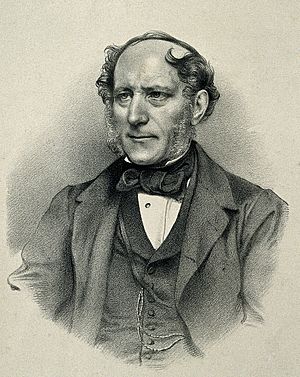Joseph Barnard Davis facts for kids
Joseph Barnard Davis (born in 1801, died May 19, 1881) was an English medical doctor. He is mostly remembered today for his large collection of skulls and his studies of human skulls, a field called craniology.
His Life and Work
Joseph Barnard Davis started his medical journey early. In the summer of 1820, while still a student, he worked as a surgeon on a whaling ship in the Arctic. He earned his first medical qualification in 1823. Twenty years later, he became a member of the College of Surgeons. In 1862, he earned his M.D. degree from the University of St Andrews.
He lived and worked as a doctor in Shelton, Staffordshire (which is now part of Hanley) until he passed away in 1881. In 1868, he was chosen as a Fellow of the Royal Society, which is a big honor for scientists.
Joseph Barnard Davis was also very involved in his local community. He was an important member of the Athenaeum in Stoke-upon-Trent. He helped create the first Museum of Natural History, Pottery, and Antiquities in the area.
His Collections and Books
In 1836, he wrote a book called Popular Manual of the Art of Preserving Health.
Davis was famous for collecting a huge number of human skulls and skeletons from different groups of people. His collection was very special because almost all the skulls had information about where they came from. By 1867, his collection had 1,474 skulls, which was more than all other British public museums combined!
He started his personal collection in 1848 by buying two skulls. Later, in 1861, he bought more skulls from the collection of James De Ville, who was a phrenologist (someone who studied the shape of the skull). Davis also wrote letters to travelers and collectors all over the world to get more specimens.
From 1856 to 1865, he worked with John Thurnam to publish a major work called Crania Britannica. This book included drawings and descriptions of skulls from the early people who lived in the British islands.
In 1867, he published a catalog of his collection called Thesaurus Craniorum. This book described and showed many of his specimens, and it included 25,000 measurements. A supplement to this book was published in 1875. Around 1879 or 1880, the Royal College of Surgeons bought his entire collection, which by then had 1,800 skulls and some skeletons.
Besides human remains, Davis also loved collecting books, photographs, drawings, and artifacts from many different cultures. His collection included art and items gathered by George Augustus Robinson from Tasmania and Victoria, Australia. Davis bought these Australian items after Robinson's death. He also bought artworks about Tasmanian Aboriginal people directly from the artist John Skinner Prout.
He was also interested in the ancient history of his local area in north Staffordshire. He collected rare carved runic calendar sticks from that region. He wrote a detailed article about these sticks in 1867.
For several years starting in 1870, he was an editor for the Journal of Anthropology and Anthropologia.
After his death, Davis's collection was sold off in auctions in London. Many items from Oceania, Asia, the Americas, and Africa were bought by Augustus Wollaston Franks and later given to the British Museum.
His Studies on Human Variation
Joseph Barnard Davis studied human differences using comparative anatomy, which is comparing the body structures of different groups. He believed that studying anatomy could show differences between human populations.
He also presented a paper in 1868 about brain weight. He published a work called Contributions towards Determining the Weight of the Brain in Different Races of Man. In another paper in 1869, he discussed the weight of the brain in different groups of people. His collection of skulls helped him explore variations in human anatomy.


